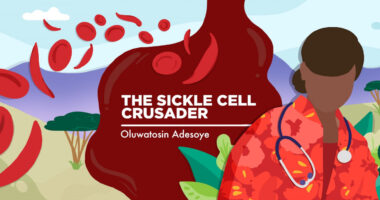Skin grafts for leg ulcers can help with wound healing, pain relief
Skin grafting may help SCD patients avoid strong opioids for pain management

Skin grafts can ease pain associated with leg ulcers and improve wound healing in people with sickle cell disease (SCD), according to a study in France.
The procedure consists of the surgical collection of a piece of healthy skin on the body that is then transplanted to the injured area.
“Skin grafting could be a temporary solution to avoid therapeutic escalation of analgesics [pain killers], in particular to avoid the use of strong opioids in these patients,” researchers wrote.
The study, “‘SCULP’ study: The benefits of skin graft pellets on the pain of sickle cell leg ulcers (SCLU),” was published in JMV-Journal de Médecine Vasculaire.
SCD is caused by mutations in the HBB gene, leading to the production of a faulty version of hemoglobin, the protein in red blood cells that carries oxygen. This causes the cells to assume a sickle-like shape, leading to blockages of blood vessels that result in painful vaso-occlusive crises and other disease symptoms.
Higher risk of painful leg ulcers in sickle cell patients
People with SCD are also at a higher risk of developing leg ulcers, which are painful open sores that do not heal. These wounds can greatly affect a patient’s quality of life because of delayed healing, recurrences, and chronic pain that requires strong opioids in around 30% of cases.
“However, despite [SCD] therapeutic advances, there is no specific recommendation for the treatment of SCLU [SCD-related leg ulcers]” in these patients, the researchers wrote.
Current treatment of SCD-related leg ulcers mainly consists of standard local wound care, compression of leg veins to improve blood flow, and keeping hemoglobin levels as high as possible.
Skin grafts are used to promote healing and pain relief for this and other types of chronic wounds, but their effect on SCD-related leg ulcers was not been studied before.
Therefore, researchers in Paris, France, analyzed data from 25 adult patients with one or more leg ulcers for at least four weeks (or two weeks in cases of recurrent wounds) who were hospitalized for a skin graft at any time from 2019 to spring 2023.
Patients were a median age of 45.5 years, and more than two-thirds (68%) were men. Most had the most frequent and severe form of SCD, caused by mutations in both HBB gene copies (96%), and had a previous history of leg ulcers (88%).
A total of 53 skin grafts were transplanted to 35 leg ulcers from 2019 to 2023. All grafts were collected from the patient’s own healthy skin tissue.
The effect of skin grafting on leg ulcer pain was evaluated through changes in the visual analog scale (VAS), which is widely used to measure pain intensity, with zero meaning no pain and 10 reflecting the worst pain, and in weekly analgesic doses.
Before skin grafting, the mean VAS score was 4.43, with about half of the patients (53.1%) reporting nerve damage-related pain.
“The most commonly used pharmaceutical class was a combination of non-opioid/adjuvant analgesics and strong opioids,” the researchers wrote.
Non-opioids include paracetamol, commonly known as Tylenol, while adjuvant analgesics, such as antidepressants, enhance the effects of pain medications. Strong opioids include morphine, while tramadol, codeine-paracetamol, and derivatives are considered mild opioids.
Skin grafting could be a temporary solution to avoid therapeutic escalation of analgesics [pain killers], in particular to avoid the use of strong opioids in these patients.
Nearly third of patients used strong opioids for ulcer pain
Nearly one-third of patients (31.4%) used strong opioids to relieve ulcer pain.
Based on VAS scores, pain was significantly reduced by 58.2% seven days after the skin graft and by 50.1% after one month.
Dosage of pain medications also showed a significant drop after one week: by 30.6% for non-opioids, 59.4% for mild opioids, and 42.4% for strong opioids. At one month, analgesic consumption was still lower than that before skin grafts: by 29.6% for mild opioids, 18% for non-opioids, and 17.3% for strong opioids. However, differences only reached statistical significance for mild opioids.
“The maximum analgesic effect occurred in the first week skin post-grafting, and diminished over time, justifying the use of several successive skin grafts in some cases, in line with clinical practice,” the researchers wrote.
Moreover, one month after the skin graft, the mean surface area of leg ulcers was significantly decreased by 76% (from 22.5 to 5.3 cm2). Complete wound healing was achieved by 37.1% of the patients after three months and by 60% after six months. Complete healing took a median of 12 weeks (about three months).
Some patients report improved quality of life one month after skin grafts
Data on quality of life was only available for four patients, who reported improvements one month after receiving skin grafts.
“The main strength of our study is that it is the first to assess the impact of skin grafting in SCLU on pain and healing,” the team wrote. “Pinch skin grafting has a significant early analgesic effect in the management of patients with SCLU, and significantly reduces wound surface area at 1 month.”
However, “we were unable to assess in this study whether … skin grafting was more effective in terms of analgesia than standard medical treatment, due to the absence of a control group,” the researchers wrote.
More studies, including an appropriately controlled trial with a higher number of patients, “could enable skin grafts to be better positioned in the therapeutic strategy for SCLU in comparison with standard medical treatment, for their analgesic effect and also for their effect on wound healing,” the researchers concluded.








